Taxation Law in Australia: Comprehensive Analysis and Application
VerifiedAdded on 2021/04/24
|15
|3143
|126
Homework Assignment
AI Summary
This assignment solution delves into the intricacies of Australian taxation law, addressing key aspects such as income tax, deductions, and residency. The solution analyzes various scenarios, including the determination of taxable income, the application of progressive tax systems, and the treatment of different types of income, allowances, and deductions as per the Income Tax Assessment Act 1997 (ITAA 1997). It also explores the concept of residency and its implications, referencing relevant tax rulings and case laws. The assignment further calculates tax liabilities based on specific income levels and examines the application of capital allowances and the treatment of non-assessable non-exempt income. Finally, the solution addresses the tax implications of various income sources, including salaries, interest, winnings, and payments for restrictive covenants, providing a detailed breakdown of assessable income, allowable deductions, and the resulting tax payable. The assignment also provides a comparative analysis of depreciation methods and their impact on tax deductions.
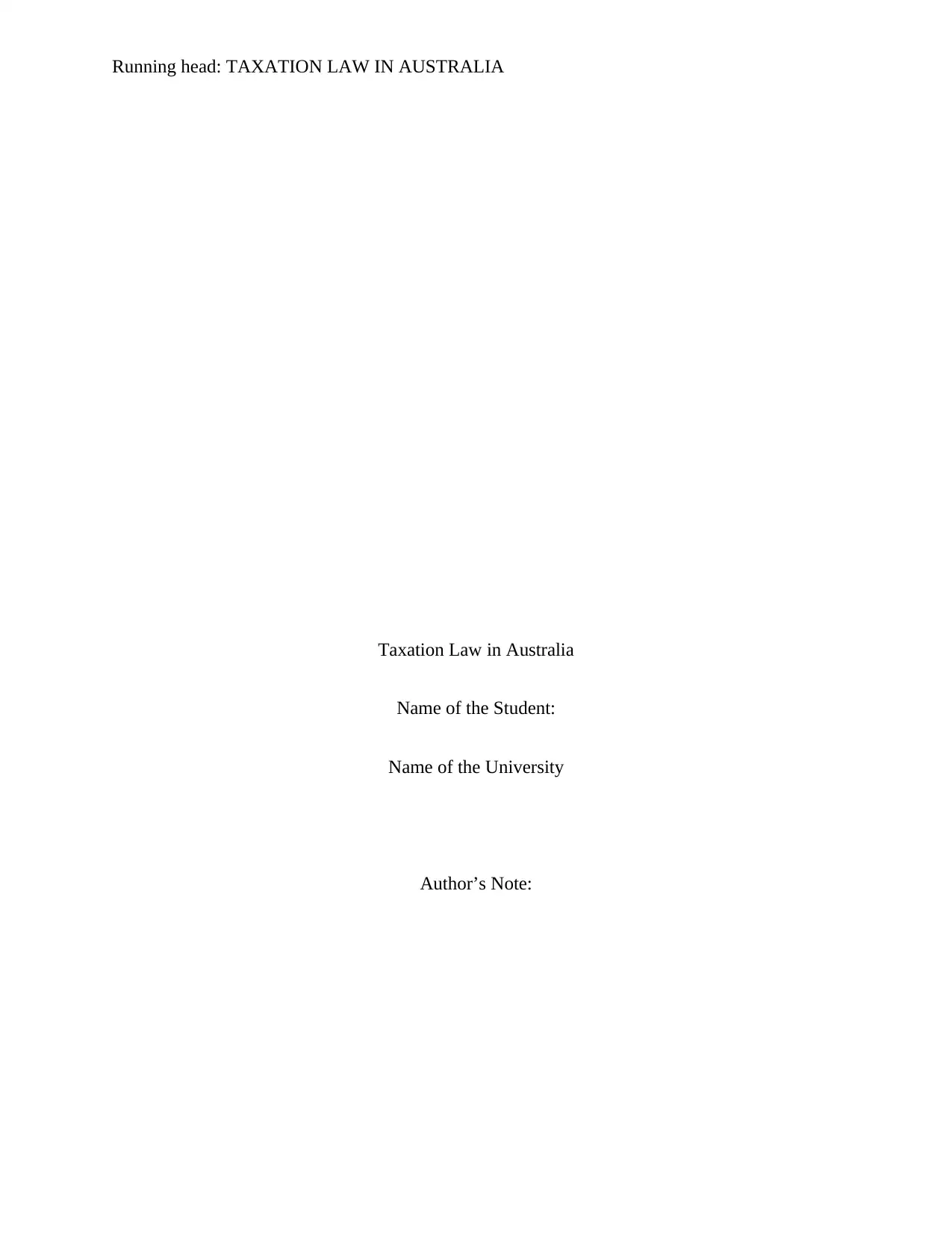
Running head: TAXATION LAW IN AUSTRALIA
Taxation Law in Australia
Name of the Student:
Name of the University
Author’s Note:
Taxation Law in Australia
Name of the Student:
Name of the University
Author’s Note:
Paraphrase This Document
Need a fresh take? Get an instant paraphrase of this document with our AI Paraphraser
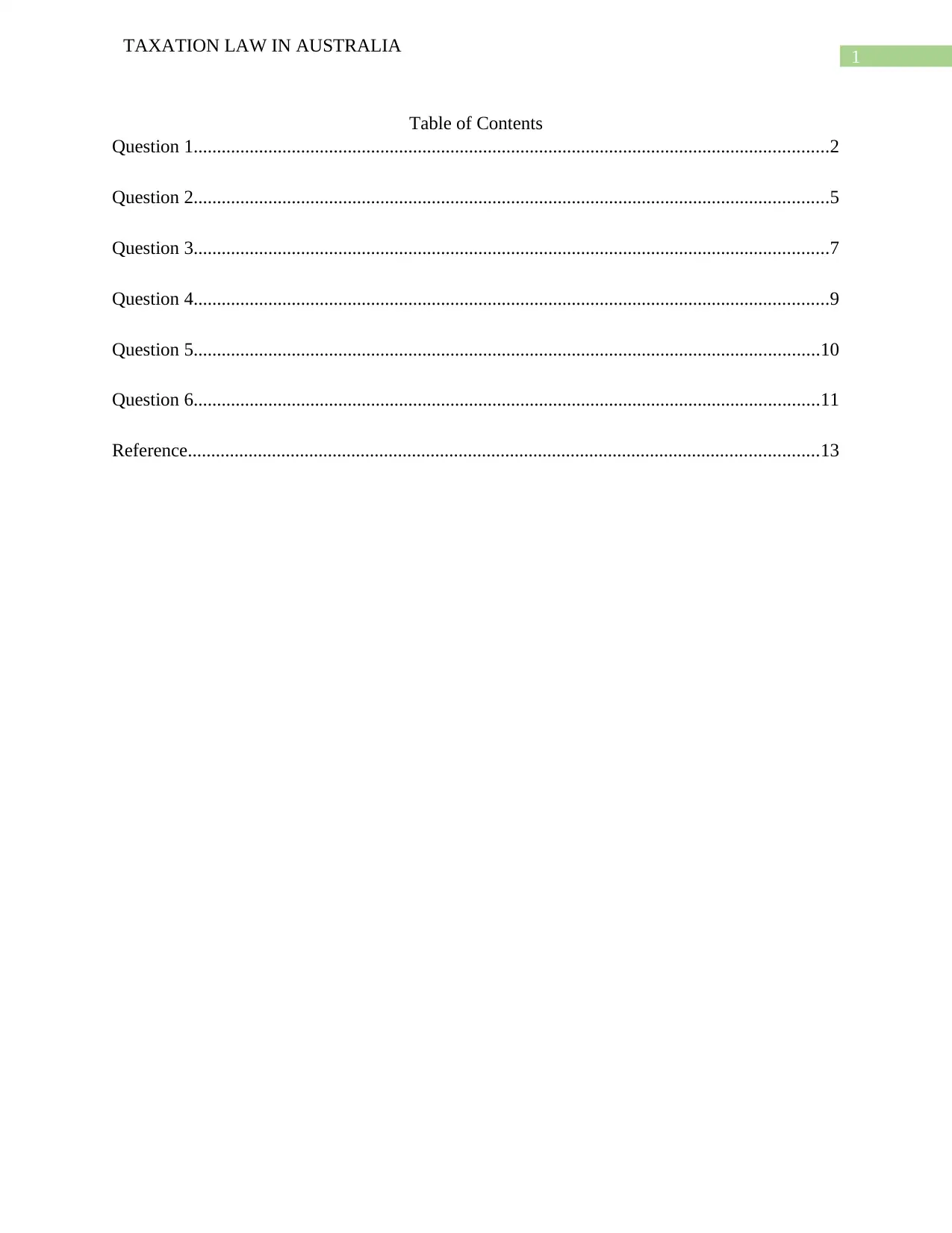
1
TAXATION LAW IN AUSTRALIA
Table of Contents
Question 1........................................................................................................................................2
Question 2........................................................................................................................................5
Question 3........................................................................................................................................7
Question 4........................................................................................................................................9
Question 5......................................................................................................................................10
Question 6......................................................................................................................................11
Reference.......................................................................................................................................13
TAXATION LAW IN AUSTRALIA
Table of Contents
Question 1........................................................................................................................................2
Question 2........................................................................................................................................5
Question 3........................................................................................................................................7
Question 4........................................................................................................................................9
Question 5......................................................................................................................................10
Question 6......................................................................................................................................11
Reference.......................................................................................................................................13
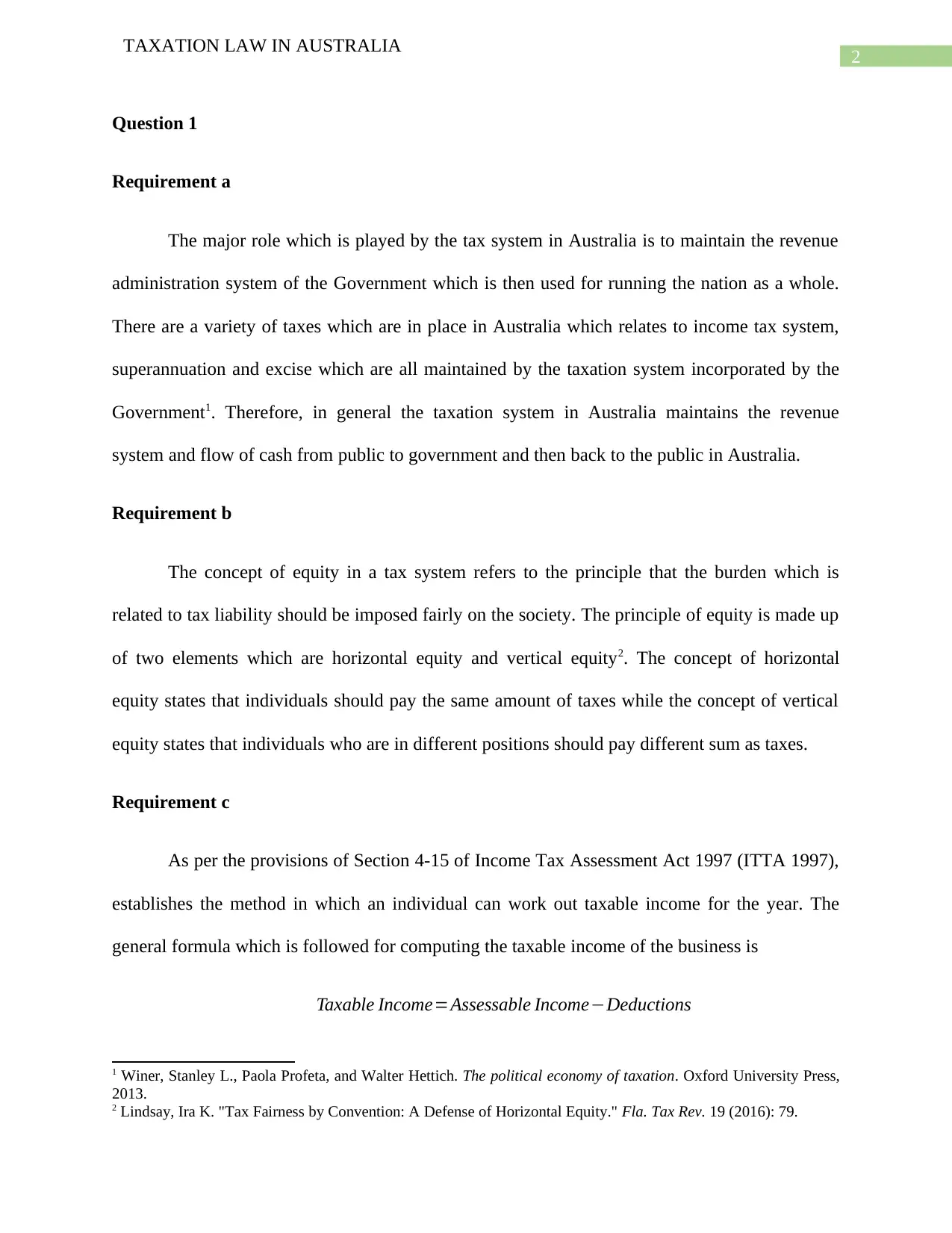
2
TAXATION LAW IN AUSTRALIA
Question 1
Requirement a
The major role which is played by the tax system in Australia is to maintain the revenue
administration system of the Government which is then used for running the nation as a whole.
There are a variety of taxes which are in place in Australia which relates to income tax system,
superannuation and excise which are all maintained by the taxation system incorporated by the
Government1. Therefore, in general the taxation system in Australia maintains the revenue
system and flow of cash from public to government and then back to the public in Australia.
Requirement b
The concept of equity in a tax system refers to the principle that the burden which is
related to tax liability should be imposed fairly on the society. The principle of equity is made up
of two elements which are horizontal equity and vertical equity2. The concept of horizontal
equity states that individuals should pay the same amount of taxes while the concept of vertical
equity states that individuals who are in different positions should pay different sum as taxes.
Requirement c
As per the provisions of Section 4-15 of Income Tax Assessment Act 1997 (ITTA 1997),
establishes the method in which an individual can work out taxable income for the year. The
general formula which is followed for computing the taxable income of the business is
Taxable Income=Assessable Income−Deductions
1 Winer, Stanley L., Paola Profeta, and Walter Hettich. The political economy of taxation. Oxford University Press,
2013.
2 Lindsay, Ira K. "Tax Fairness by Convention: A Defense of Horizontal Equity." Fla. Tax Rev. 19 (2016): 79.
TAXATION LAW IN AUSTRALIA
Question 1
Requirement a
The major role which is played by the tax system in Australia is to maintain the revenue
administration system of the Government which is then used for running the nation as a whole.
There are a variety of taxes which are in place in Australia which relates to income tax system,
superannuation and excise which are all maintained by the taxation system incorporated by the
Government1. Therefore, in general the taxation system in Australia maintains the revenue
system and flow of cash from public to government and then back to the public in Australia.
Requirement b
The concept of equity in a tax system refers to the principle that the burden which is
related to tax liability should be imposed fairly on the society. The principle of equity is made up
of two elements which are horizontal equity and vertical equity2. The concept of horizontal
equity states that individuals should pay the same amount of taxes while the concept of vertical
equity states that individuals who are in different positions should pay different sum as taxes.
Requirement c
As per the provisions of Section 4-15 of Income Tax Assessment Act 1997 (ITTA 1997),
establishes the method in which an individual can work out taxable income for the year. The
general formula which is followed for computing the taxable income of the business is
Taxable Income=Assessable Income−Deductions
1 Winer, Stanley L., Paola Profeta, and Walter Hettich. The political economy of taxation. Oxford University Press,
2013.
2 Lindsay, Ira K. "Tax Fairness by Convention: A Defense of Horizontal Equity." Fla. Tax Rev. 19 (2016): 79.
⊘ This is a preview!⊘
Do you want full access?
Subscribe today to unlock all pages.

Trusted by 1+ million students worldwide
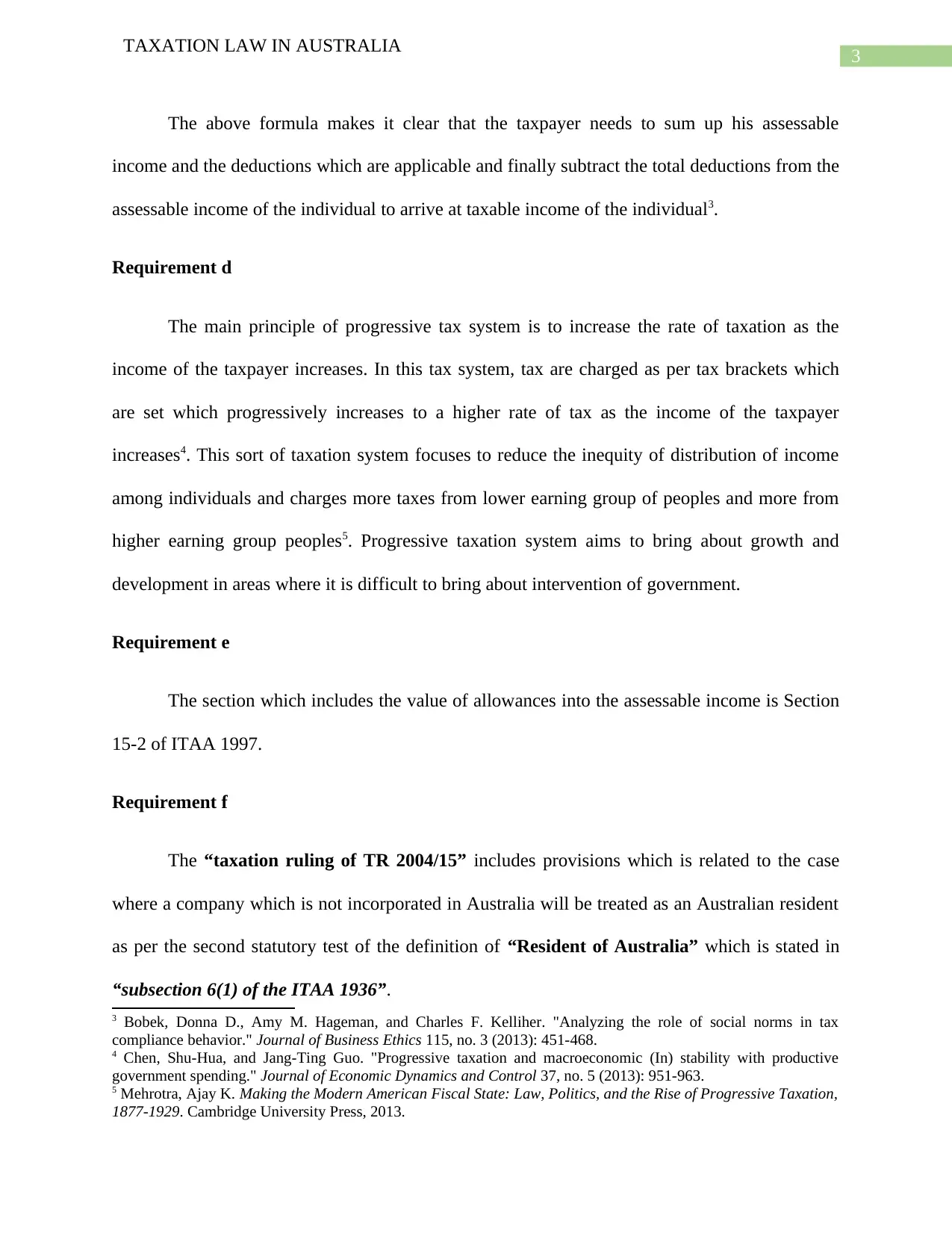
3
TAXATION LAW IN AUSTRALIA
The above formula makes it clear that the taxpayer needs to sum up his assessable
income and the deductions which are applicable and finally subtract the total deductions from the
assessable income of the individual to arrive at taxable income of the individual3.
Requirement d
The main principle of progressive tax system is to increase the rate of taxation as the
income of the taxpayer increases. In this tax system, tax are charged as per tax brackets which
are set which progressively increases to a higher rate of tax as the income of the taxpayer
increases4. This sort of taxation system focuses to reduce the inequity of distribution of income
among individuals and charges more taxes from lower earning group of peoples and more from
higher earning group peoples5. Progressive taxation system aims to bring about growth and
development in areas where it is difficult to bring about intervention of government.
Requirement e
The section which includes the value of allowances into the assessable income is Section
15-2 of ITAA 1997.
Requirement f
The “taxation ruling of TR 2004/15” includes provisions which is related to the case
where a company which is not incorporated in Australia will be treated as an Australian resident
as per the second statutory test of the definition of “Resident of Australia” which is stated in
“subsection 6(1) of the ITAA 1936”.
3 Bobek, Donna D., Amy M. Hageman, and Charles F. Kelliher. "Analyzing the role of social norms in tax
compliance behavior." Journal of Business Ethics 115, no. 3 (2013): 451-468.
4 Chen, Shu-Hua, and Jang-Ting Guo. "Progressive taxation and macroeconomic (In) stability with productive
government spending." Journal of Economic Dynamics and Control 37, no. 5 (2013): 951-963.
5 Mehrotra, Ajay K. Making the Modern American Fiscal State: Law, Politics, and the Rise of Progressive Taxation,
1877-1929. Cambridge University Press, 2013.
TAXATION LAW IN AUSTRALIA
The above formula makes it clear that the taxpayer needs to sum up his assessable
income and the deductions which are applicable and finally subtract the total deductions from the
assessable income of the individual to arrive at taxable income of the individual3.
Requirement d
The main principle of progressive tax system is to increase the rate of taxation as the
income of the taxpayer increases. In this tax system, tax are charged as per tax brackets which
are set which progressively increases to a higher rate of tax as the income of the taxpayer
increases4. This sort of taxation system focuses to reduce the inequity of distribution of income
among individuals and charges more taxes from lower earning group of peoples and more from
higher earning group peoples5. Progressive taxation system aims to bring about growth and
development in areas where it is difficult to bring about intervention of government.
Requirement e
The section which includes the value of allowances into the assessable income is Section
15-2 of ITAA 1997.
Requirement f
The “taxation ruling of TR 2004/15” includes provisions which is related to the case
where a company which is not incorporated in Australia will be treated as an Australian resident
as per the second statutory test of the definition of “Resident of Australia” which is stated in
“subsection 6(1) of the ITAA 1936”.
3 Bobek, Donna D., Amy M. Hageman, and Charles F. Kelliher. "Analyzing the role of social norms in tax
compliance behavior." Journal of Business Ethics 115, no. 3 (2013): 451-468.
4 Chen, Shu-Hua, and Jang-Ting Guo. "Progressive taxation and macroeconomic (In) stability with productive
government spending." Journal of Economic Dynamics and Control 37, no. 5 (2013): 951-963.
5 Mehrotra, Ajay K. Making the Modern American Fiscal State: Law, Politics, and the Rise of Progressive Taxation,
1877-1929. Cambridge University Press, 2013.
Paraphrase This Document
Need a fresh take? Get an instant paraphrase of this document with our AI Paraphraser
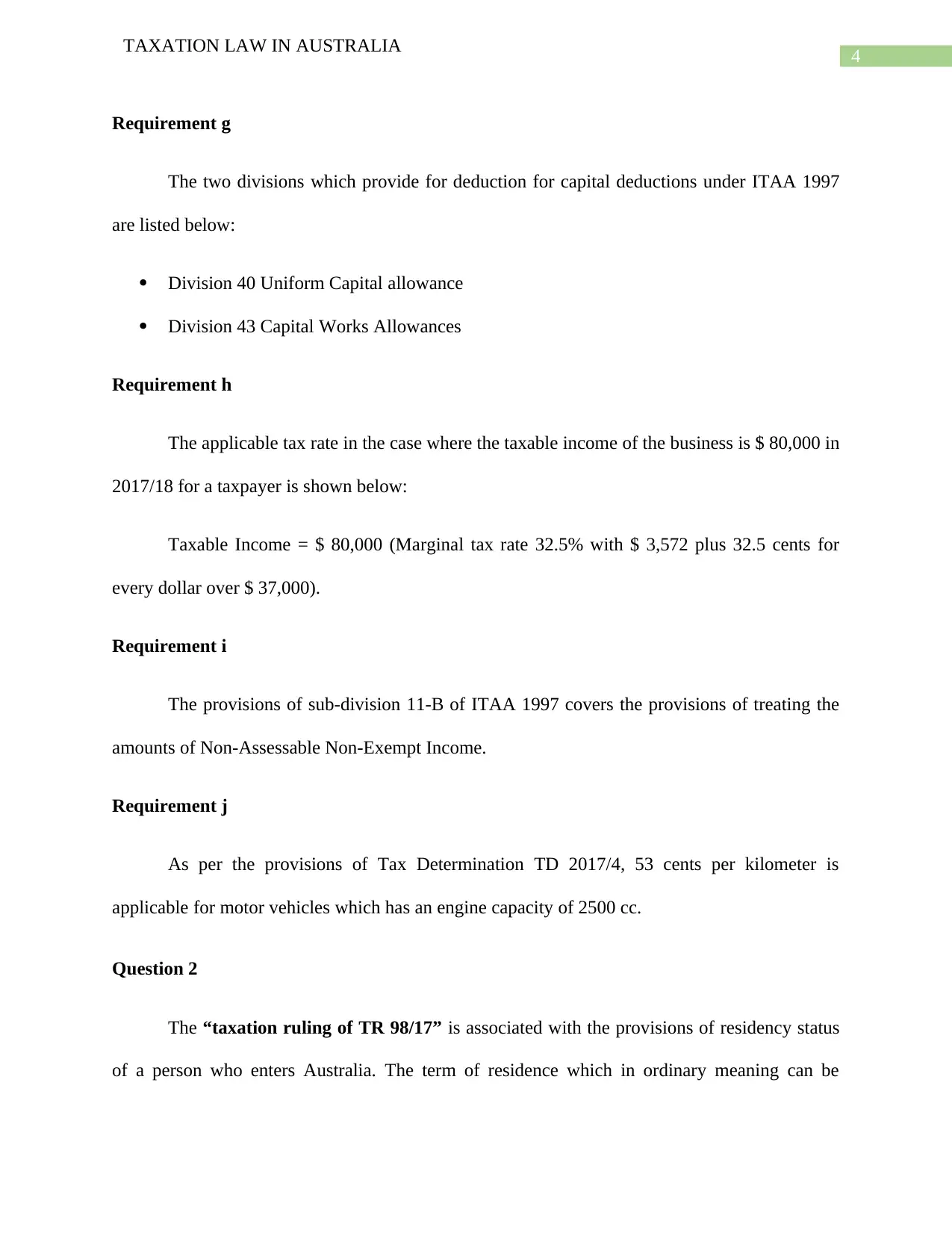
4
TAXATION LAW IN AUSTRALIA
Requirement g
The two divisions which provide for deduction for capital deductions under ITAA 1997
are listed below:
Division 40 Uniform Capital allowance
Division 43 Capital Works Allowances
Requirement h
The applicable tax rate in the case where the taxable income of the business is $ 80,000 in
2017/18 for a taxpayer is shown below:
Taxable Income = $ 80,000 (Marginal tax rate 32.5% with $ 3,572 plus 32.5 cents for
every dollar over $ 37,000).
Requirement i
The provisions of sub-division 11-B of ITAA 1997 covers the provisions of treating the
amounts of Non-Assessable Non-Exempt Income.
Requirement j
As per the provisions of Tax Determination TD 2017/4, 53 cents per kilometer is
applicable for motor vehicles which has an engine capacity of 2500 cc.
Question 2
The “taxation ruling of TR 98/17” is associated with the provisions of residency status
of a person who enters Australia. The term of residence which in ordinary meaning can be
TAXATION LAW IN AUSTRALIA
Requirement g
The two divisions which provide for deduction for capital deductions under ITAA 1997
are listed below:
Division 40 Uniform Capital allowance
Division 43 Capital Works Allowances
Requirement h
The applicable tax rate in the case where the taxable income of the business is $ 80,000 in
2017/18 for a taxpayer is shown below:
Taxable Income = $ 80,000 (Marginal tax rate 32.5% with $ 3,572 plus 32.5 cents for
every dollar over $ 37,000).
Requirement i
The provisions of sub-division 11-B of ITAA 1997 covers the provisions of treating the
amounts of Non-Assessable Non-Exempt Income.
Requirement j
As per the provisions of Tax Determination TD 2017/4, 53 cents per kilometer is
applicable for motor vehicles which has an engine capacity of 2500 cc.
Question 2
The “taxation ruling of TR 98/17” is associated with the provisions of residency status
of a person who enters Australia. The term of residence which in ordinary meaning can be
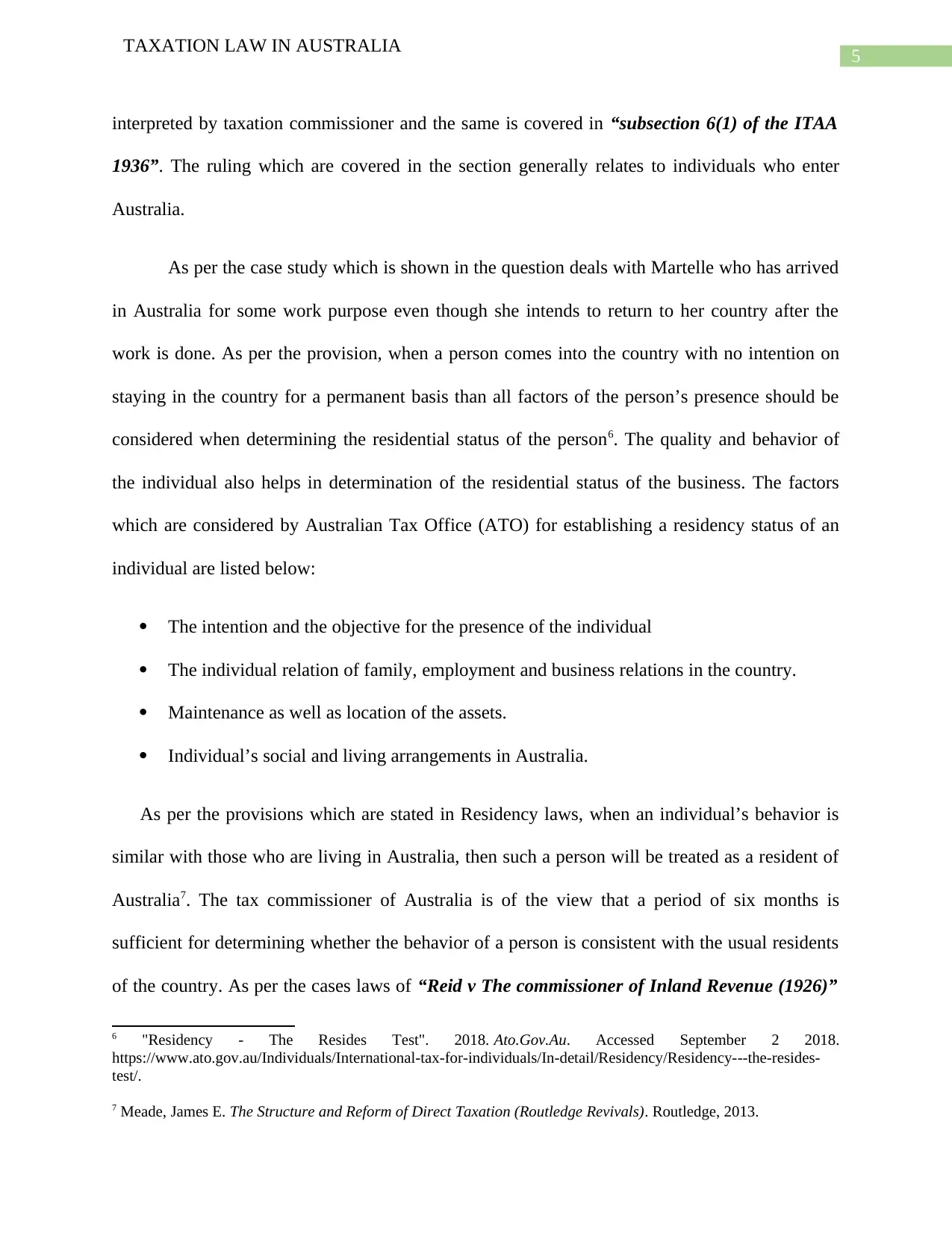
5
TAXATION LAW IN AUSTRALIA
interpreted by taxation commissioner and the same is covered in “subsection 6(1) of the ITAA
1936”. The ruling which are covered in the section generally relates to individuals who enter
Australia.
As per the case study which is shown in the question deals with Martelle who has arrived
in Australia for some work purpose even though she intends to return to her country after the
work is done. As per the provision, when a person comes into the country with no intention on
staying in the country for a permanent basis than all factors of the person’s presence should be
considered when determining the residential status of the person6. The quality and behavior of
the individual also helps in determination of the residential status of the business. The factors
which are considered by Australian Tax Office (ATO) for establishing a residency status of an
individual are listed below:
The intention and the objective for the presence of the individual
The individual relation of family, employment and business relations in the country.
Maintenance as well as location of the assets.
Individual’s social and living arrangements in Australia.
As per the provisions which are stated in Residency laws, when an individual’s behavior is
similar with those who are living in Australia, then such a person will be treated as a resident of
Australia7. The tax commissioner of Australia is of the view that a period of six months is
sufficient for determining whether the behavior of a person is consistent with the usual residents
of the country. As per the cases laws of “Reid v The commissioner of Inland Revenue (1926)”
6 "Residency - The Resides Test". 2018. Ato.Gov.Au. Accessed September 2 2018.
https://www.ato.gov.au/Individuals/International-tax-for-individuals/In-detail/Residency/Residency---the-resides-
test/.
7 Meade, James E. The Structure and Reform of Direct Taxation (Routledge Revivals). Routledge, 2013.
TAXATION LAW IN AUSTRALIA
interpreted by taxation commissioner and the same is covered in “subsection 6(1) of the ITAA
1936”. The ruling which are covered in the section generally relates to individuals who enter
Australia.
As per the case study which is shown in the question deals with Martelle who has arrived
in Australia for some work purpose even though she intends to return to her country after the
work is done. As per the provision, when a person comes into the country with no intention on
staying in the country for a permanent basis than all factors of the person’s presence should be
considered when determining the residential status of the person6. The quality and behavior of
the individual also helps in determination of the residential status of the business. The factors
which are considered by Australian Tax Office (ATO) for establishing a residency status of an
individual are listed below:
The intention and the objective for the presence of the individual
The individual relation of family, employment and business relations in the country.
Maintenance as well as location of the assets.
Individual’s social and living arrangements in Australia.
As per the provisions which are stated in Residency laws, when an individual’s behavior is
similar with those who are living in Australia, then such a person will be treated as a resident of
Australia7. The tax commissioner of Australia is of the view that a period of six months is
sufficient for determining whether the behavior of a person is consistent with the usual residents
of the country. As per the cases laws of “Reid v The commissioner of Inland Revenue (1926)”
6 "Residency - The Resides Test". 2018. Ato.Gov.Au. Accessed September 2 2018.
https://www.ato.gov.au/Individuals/International-tax-for-individuals/In-detail/Residency/Residency---the-resides-
test/.
7 Meade, James E. The Structure and Reform of Direct Taxation (Routledge Revivals). Routledge, 2013.
⊘ This is a preview!⊘
Do you want full access?
Subscribe today to unlock all pages.

Trusted by 1+ million students worldwide
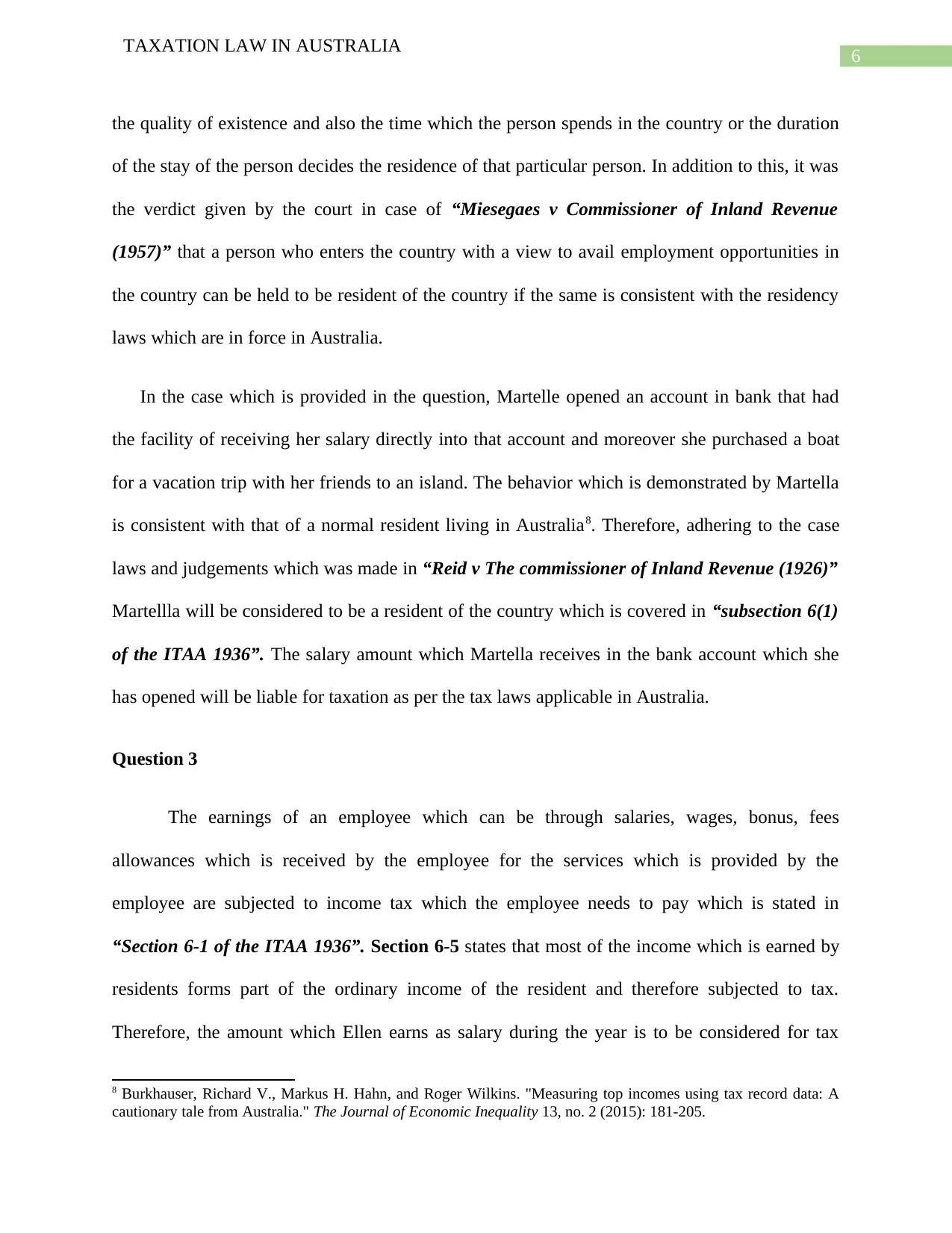
6
TAXATION LAW IN AUSTRALIA
the quality of existence and also the time which the person spends in the country or the duration
of the stay of the person decides the residence of that particular person. In addition to this, it was
the verdict given by the court in case of “Miesegaes v Commissioner of Inland Revenue
(1957)” that a person who enters the country with a view to avail employment opportunities in
the country can be held to be resident of the country if the same is consistent with the residency
laws which are in force in Australia.
In the case which is provided in the question, Martelle opened an account in bank that had
the facility of receiving her salary directly into that account and moreover she purchased a boat
for a vacation trip with her friends to an island. The behavior which is demonstrated by Martella
is consistent with that of a normal resident living in Australia8. Therefore, adhering to the case
laws and judgements which was made in “Reid v The commissioner of Inland Revenue (1926)”
Martellla will be considered to be a resident of the country which is covered in “subsection 6(1)
of the ITAA 1936”. The salary amount which Martella receives in the bank account which she
has opened will be liable for taxation as per the tax laws applicable in Australia.
Question 3
The earnings of an employee which can be through salaries, wages, bonus, fees
allowances which is received by the employee for the services which is provided by the
employee are subjected to income tax which the employee needs to pay which is stated in
“Section 6-1 of the ITAA 1936”. Section 6-5 states that most of the income which is earned by
residents forms part of the ordinary income of the resident and therefore subjected to tax.
Therefore, the amount which Ellen earns as salary during the year is to be considered for tax
8 Burkhauser, Richard V., Markus H. Hahn, and Roger Wilkins. "Measuring top incomes using tax record data: A
cautionary tale from Australia." The Journal of Economic Inequality 13, no. 2 (2015): 181-205.
TAXATION LAW IN AUSTRALIA
the quality of existence and also the time which the person spends in the country or the duration
of the stay of the person decides the residence of that particular person. In addition to this, it was
the verdict given by the court in case of “Miesegaes v Commissioner of Inland Revenue
(1957)” that a person who enters the country with a view to avail employment opportunities in
the country can be held to be resident of the country if the same is consistent with the residency
laws which are in force in Australia.
In the case which is provided in the question, Martelle opened an account in bank that had
the facility of receiving her salary directly into that account and moreover she purchased a boat
for a vacation trip with her friends to an island. The behavior which is demonstrated by Martella
is consistent with that of a normal resident living in Australia8. Therefore, adhering to the case
laws and judgements which was made in “Reid v The commissioner of Inland Revenue (1926)”
Martellla will be considered to be a resident of the country which is covered in “subsection 6(1)
of the ITAA 1936”. The salary amount which Martella receives in the bank account which she
has opened will be liable for taxation as per the tax laws applicable in Australia.
Question 3
The earnings of an employee which can be through salaries, wages, bonus, fees
allowances which is received by the employee for the services which is provided by the
employee are subjected to income tax which the employee needs to pay which is stated in
“Section 6-1 of the ITAA 1936”. Section 6-5 states that most of the income which is earned by
residents forms part of the ordinary income of the resident and therefore subjected to tax.
Therefore, the amount which Ellen earns as salary during the year is to be considered for tax
8 Burkhauser, Richard V., Markus H. Hahn, and Roger Wilkins. "Measuring top incomes using tax record data: A
cautionary tale from Australia." The Journal of Economic Inequality 13, no. 2 (2015): 181-205.
Paraphrase This Document
Need a fresh take? Get an instant paraphrase of this document with our AI Paraphraser
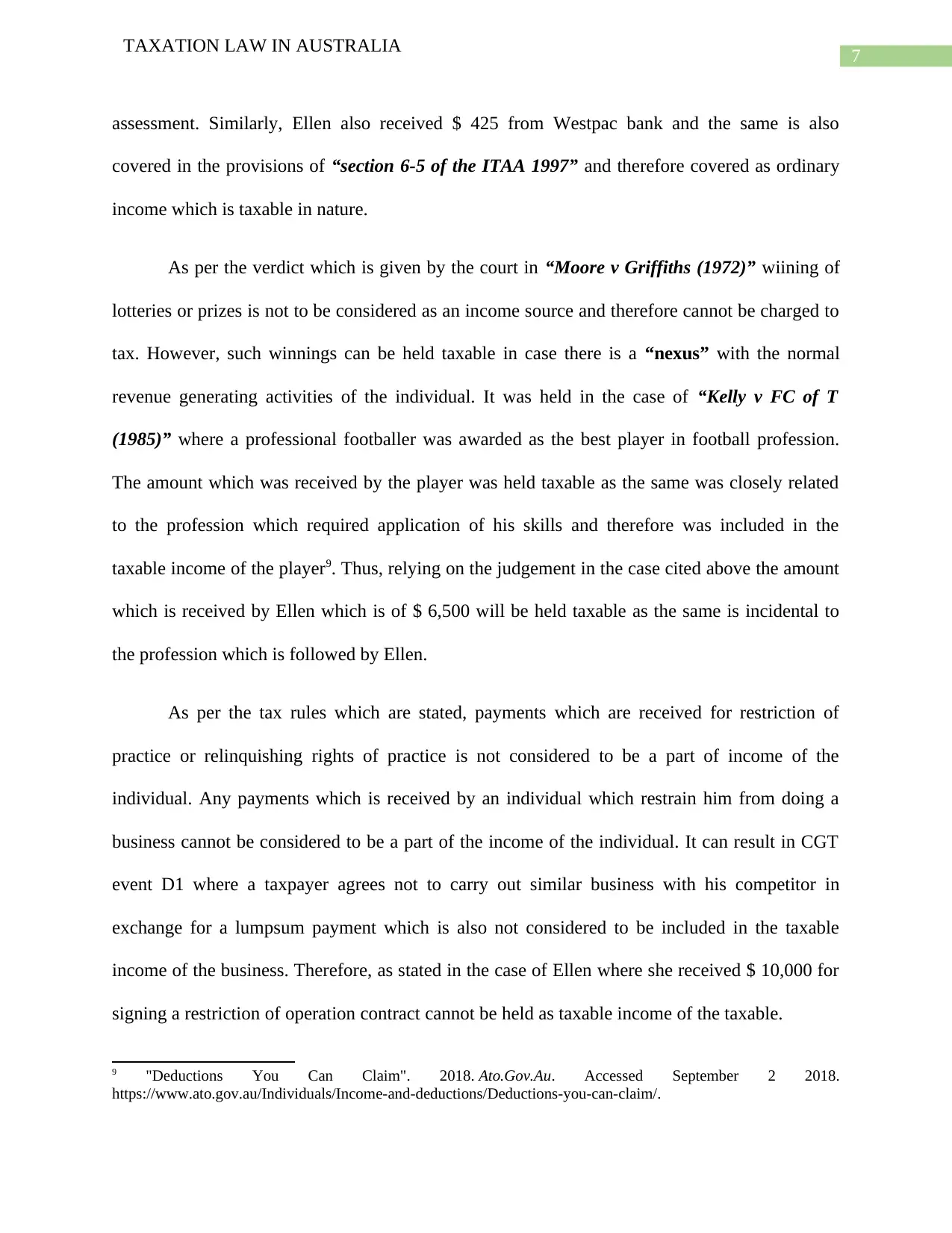
7
TAXATION LAW IN AUSTRALIA
assessment. Similarly, Ellen also received $ 425 from Westpac bank and the same is also
covered in the provisions of “section 6-5 of the ITAA 1997” and therefore covered as ordinary
income which is taxable in nature.
As per the verdict which is given by the court in “Moore v Griffiths (1972)” wiining of
lotteries or prizes is not to be considered as an income source and therefore cannot be charged to
tax. However, such winnings can be held taxable in case there is a “nexus” with the normal
revenue generating activities of the individual. It was held in the case of “Kelly v FC of T
(1985)” where a professional footballer was awarded as the best player in football profession.
The amount which was received by the player was held taxable as the same was closely related
to the profession which required application of his skills and therefore was included in the
taxable income of the player9. Thus, relying on the judgement in the case cited above the amount
which is received by Ellen which is of $ 6,500 will be held taxable as the same is incidental to
the profession which is followed by Ellen.
As per the tax rules which are stated, payments which are received for restriction of
practice or relinquishing rights of practice is not considered to be a part of income of the
individual. Any payments which is received by an individual which restrain him from doing a
business cannot be considered to be a part of the income of the individual. It can result in CGT
event D1 where a taxpayer agrees not to carry out similar business with his competitor in
exchange for a lumpsum payment which is also not considered to be included in the taxable
income of the business. Therefore, as stated in the case of Ellen where she received $ 10,000 for
signing a restriction of operation contract cannot be held as taxable income of the taxable.
9 "Deductions You Can Claim". 2018. Ato.Gov.Au. Accessed September 2 2018.
https://www.ato.gov.au/Individuals/Income-and-deductions/Deductions-you-can-claim/.
TAXATION LAW IN AUSTRALIA
assessment. Similarly, Ellen also received $ 425 from Westpac bank and the same is also
covered in the provisions of “section 6-5 of the ITAA 1997” and therefore covered as ordinary
income which is taxable in nature.
As per the verdict which is given by the court in “Moore v Griffiths (1972)” wiining of
lotteries or prizes is not to be considered as an income source and therefore cannot be charged to
tax. However, such winnings can be held taxable in case there is a “nexus” with the normal
revenue generating activities of the individual. It was held in the case of “Kelly v FC of T
(1985)” where a professional footballer was awarded as the best player in football profession.
The amount which was received by the player was held taxable as the same was closely related
to the profession which required application of his skills and therefore was included in the
taxable income of the player9. Thus, relying on the judgement in the case cited above the amount
which is received by Ellen which is of $ 6,500 will be held taxable as the same is incidental to
the profession which is followed by Ellen.
As per the tax rules which are stated, payments which are received for restriction of
practice or relinquishing rights of practice is not considered to be a part of income of the
individual. Any payments which is received by an individual which restrain him from doing a
business cannot be considered to be a part of the income of the individual. It can result in CGT
event D1 where a taxpayer agrees not to carry out similar business with his competitor in
exchange for a lumpsum payment which is also not considered to be included in the taxable
income of the business. Therefore, as stated in the case of Ellen where she received $ 10,000 for
signing a restriction of operation contract cannot be held as taxable income of the taxable.
9 "Deductions You Can Claim". 2018. Ato.Gov.Au. Accessed September 2 2018.
https://www.ato.gov.au/Individuals/Income-and-deductions/Deductions-you-can-claim/.
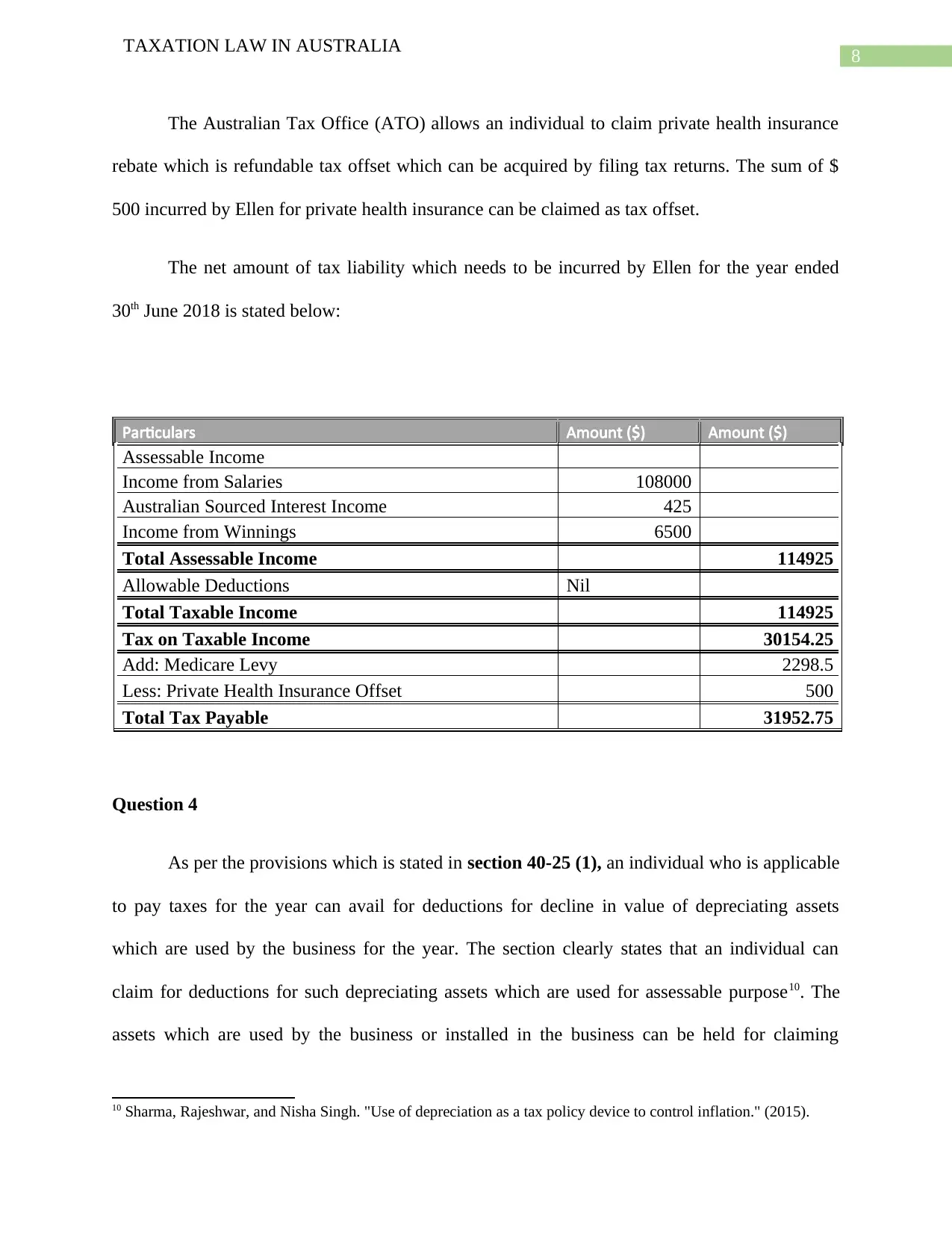
8
TAXATION LAW IN AUSTRALIA
The Australian Tax Office (ATO) allows an individual to claim private health insurance
rebate which is refundable tax offset which can be acquired by filing tax returns. The sum of $
500 incurred by Ellen for private health insurance can be claimed as tax offset.
The net amount of tax liability which needs to be incurred by Ellen for the year ended
30th June 2018 is stated below:
Particulars Amount ($) Amount ($)
Assessable Income
Income from Salaries 108000
Australian Sourced Interest Income 425
Income from Winnings 6500
Total Assessable Income 114925
Allowable Deductions Nil
Total Taxable Income 114925
Tax on Taxable Income 30154.25
Add: Medicare Levy 2298.5
Less: Private Health Insurance Offset 500
Total Tax Payable 31952.75
Question 4
As per the provisions which is stated in section 40-25 (1), an individual who is applicable
to pay taxes for the year can avail for deductions for decline in value of depreciating assets
which are used by the business for the year. The section clearly states that an individual can
claim for deductions for such depreciating assets which are used for assessable purpose10. The
assets which are used by the business or installed in the business can be held for claiming
10 Sharma, Rajeshwar, and Nisha Singh. "Use of depreciation as a tax policy device to control inflation." (2015).
TAXATION LAW IN AUSTRALIA
The Australian Tax Office (ATO) allows an individual to claim private health insurance
rebate which is refundable tax offset which can be acquired by filing tax returns. The sum of $
500 incurred by Ellen for private health insurance can be claimed as tax offset.
The net amount of tax liability which needs to be incurred by Ellen for the year ended
30th June 2018 is stated below:
Particulars Amount ($) Amount ($)
Assessable Income
Income from Salaries 108000
Australian Sourced Interest Income 425
Income from Winnings 6500
Total Assessable Income 114925
Allowable Deductions Nil
Total Taxable Income 114925
Tax on Taxable Income 30154.25
Add: Medicare Levy 2298.5
Less: Private Health Insurance Offset 500
Total Tax Payable 31952.75
Question 4
As per the provisions which is stated in section 40-25 (1), an individual who is applicable
to pay taxes for the year can avail for deductions for decline in value of depreciating assets
which are used by the business for the year. The section clearly states that an individual can
claim for deductions for such depreciating assets which are used for assessable purpose10. The
assets which are used by the business or installed in the business can be held for claiming
10 Sharma, Rajeshwar, and Nisha Singh. "Use of depreciation as a tax policy device to control inflation." (2015).
⊘ This is a preview!⊘
Do you want full access?
Subscribe today to unlock all pages.

Trusted by 1+ million students worldwide
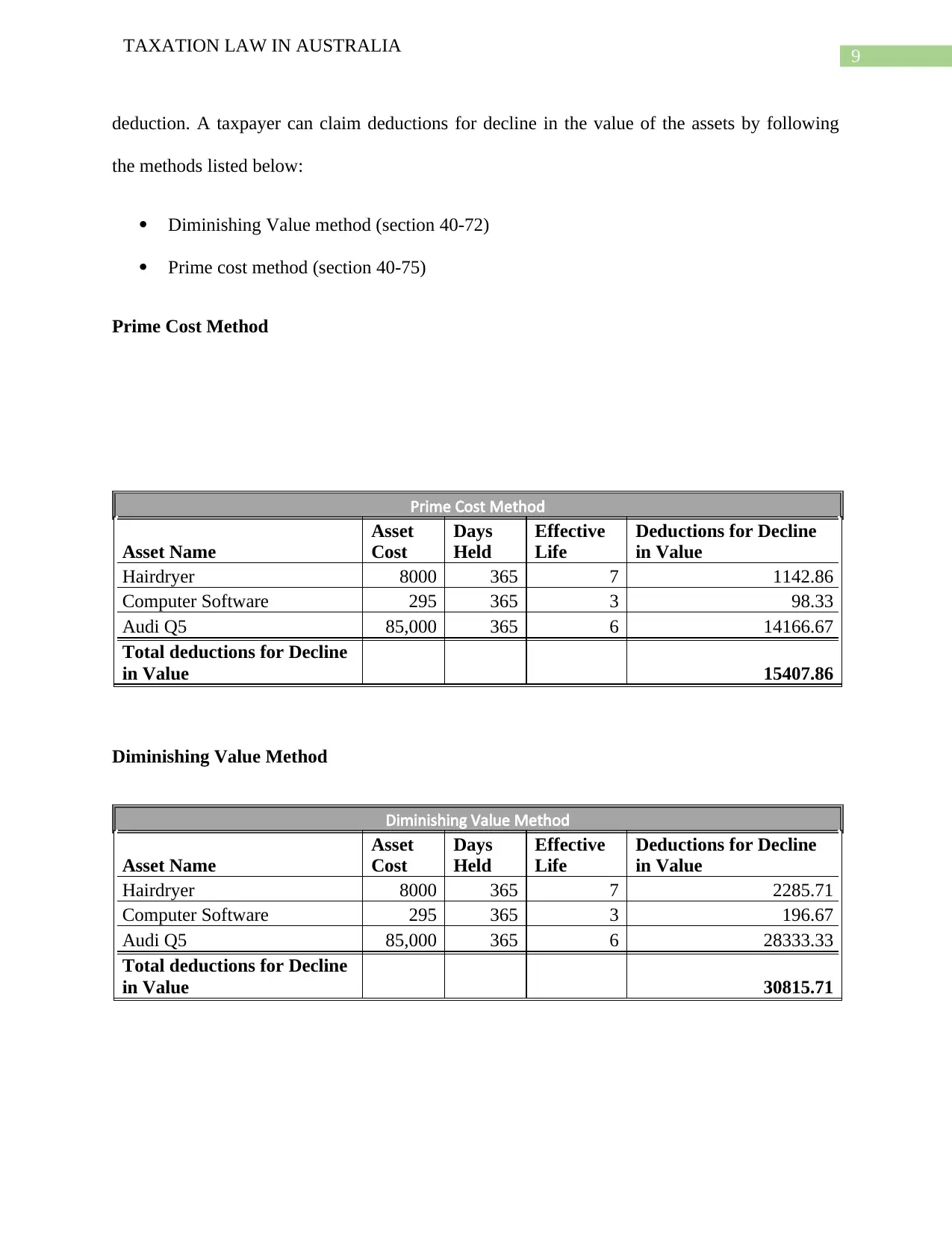
9
TAXATION LAW IN AUSTRALIA
deduction. A taxpayer can claim deductions for decline in the value of the assets by following
the methods listed below:
Diminishing Value method (section 40-72)
Prime cost method (section 40-75)
Prime Cost Method
Prime Cost Method
Asset Name
Asset
Cost
Days
Held
Effective
Life
Deductions for Decline
in Value
Hairdryer 8000 365 7 1142.86
Computer Software 295 365 3 98.33
Audi Q5 85,000 365 6 14166.67
Total deductions for Decline
in Value 15407.86
Diminishing Value Method
Diminishing Value Method
Asset Name
Asset
Cost
Days
Held
Effective
Life
Deductions for Decline
in Value
Hairdryer 8000 365 7 2285.71
Computer Software 295 365 3 196.67
Audi Q5 85,000 365 6 28333.33
Total deductions for Decline
in Value 30815.71
TAXATION LAW IN AUSTRALIA
deduction. A taxpayer can claim deductions for decline in the value of the assets by following
the methods listed below:
Diminishing Value method (section 40-72)
Prime cost method (section 40-75)
Prime Cost Method
Prime Cost Method
Asset Name
Asset
Cost
Days
Held
Effective
Life
Deductions for Decline
in Value
Hairdryer 8000 365 7 1142.86
Computer Software 295 365 3 98.33
Audi Q5 85,000 365 6 14166.67
Total deductions for Decline
in Value 15407.86
Diminishing Value Method
Diminishing Value Method
Asset Name
Asset
Cost
Days
Held
Effective
Life
Deductions for Decline
in Value
Hairdryer 8000 365 7 2285.71
Computer Software 295 365 3 196.67
Audi Q5 85,000 365 6 28333.33
Total deductions for Decline
in Value 30815.71
Paraphrase This Document
Need a fresh take? Get an instant paraphrase of this document with our AI Paraphraser
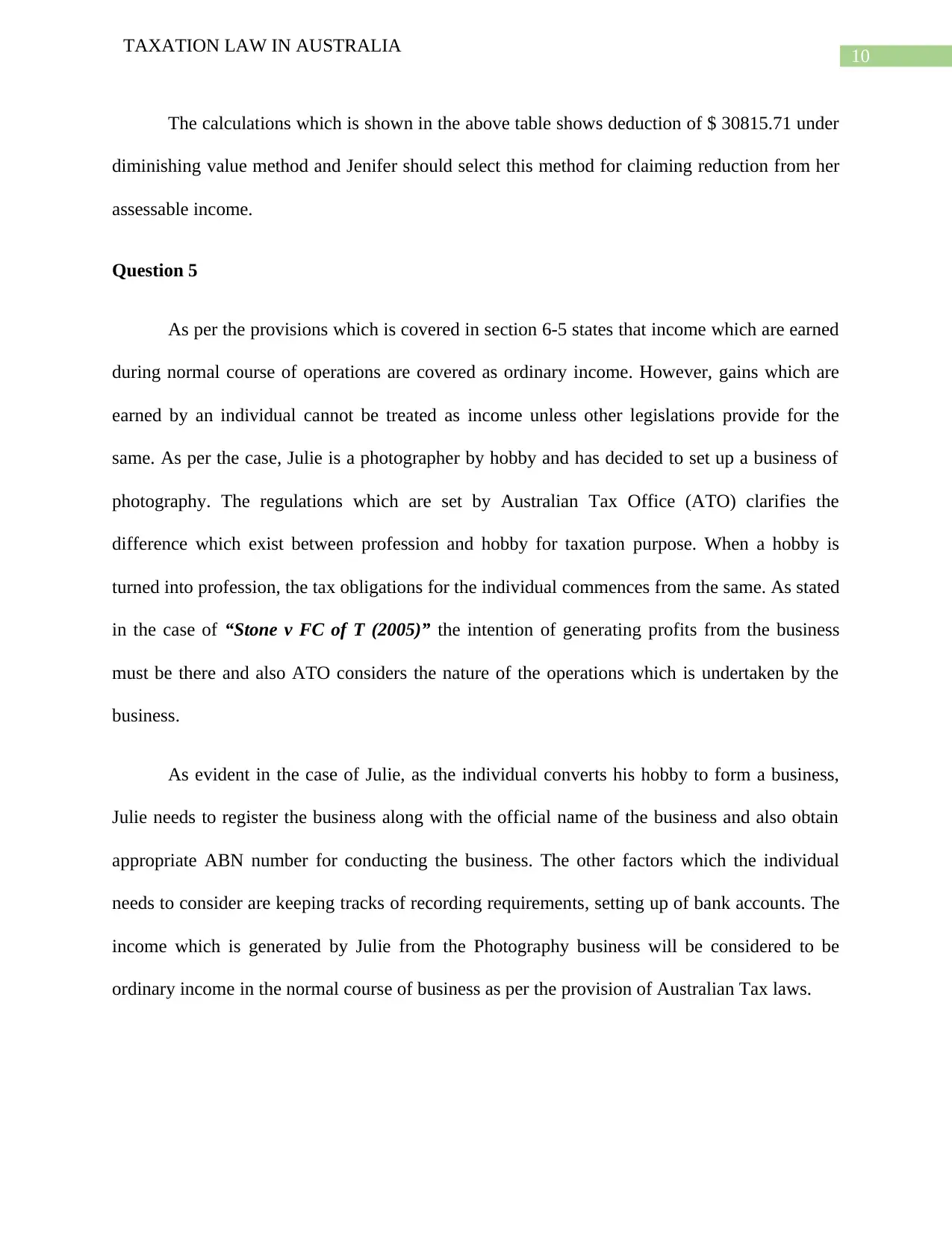
10
TAXATION LAW IN AUSTRALIA
The calculations which is shown in the above table shows deduction of $ 30815.71 under
diminishing value method and Jenifer should select this method for claiming reduction from her
assessable income.
Question 5
As per the provisions which is covered in section 6-5 states that income which are earned
during normal course of operations are covered as ordinary income. However, gains which are
earned by an individual cannot be treated as income unless other legislations provide for the
same. As per the case, Julie is a photographer by hobby and has decided to set up a business of
photography. The regulations which are set by Australian Tax Office (ATO) clarifies the
difference which exist between profession and hobby for taxation purpose. When a hobby is
turned into profession, the tax obligations for the individual commences from the same. As stated
in the case of “Stone v FC of T (2005)” the intention of generating profits from the business
must be there and also ATO considers the nature of the operations which is undertaken by the
business.
As evident in the case of Julie, as the individual converts his hobby to form a business,
Julie needs to register the business along with the official name of the business and also obtain
appropriate ABN number for conducting the business. The other factors which the individual
needs to consider are keeping tracks of recording requirements, setting up of bank accounts. The
income which is generated by Julie from the Photography business will be considered to be
ordinary income in the normal course of business as per the provision of Australian Tax laws.
TAXATION LAW IN AUSTRALIA
The calculations which is shown in the above table shows deduction of $ 30815.71 under
diminishing value method and Jenifer should select this method for claiming reduction from her
assessable income.
Question 5
As per the provisions which is covered in section 6-5 states that income which are earned
during normal course of operations are covered as ordinary income. However, gains which are
earned by an individual cannot be treated as income unless other legislations provide for the
same. As per the case, Julie is a photographer by hobby and has decided to set up a business of
photography. The regulations which are set by Australian Tax Office (ATO) clarifies the
difference which exist between profession and hobby for taxation purpose. When a hobby is
turned into profession, the tax obligations for the individual commences from the same. As stated
in the case of “Stone v FC of T (2005)” the intention of generating profits from the business
must be there and also ATO considers the nature of the operations which is undertaken by the
business.
As evident in the case of Julie, as the individual converts his hobby to form a business,
Julie needs to register the business along with the official name of the business and also obtain
appropriate ABN number for conducting the business. The other factors which the individual
needs to consider are keeping tracks of recording requirements, setting up of bank accounts. The
income which is generated by Julie from the Photography business will be considered to be
ordinary income in the normal course of business as per the provision of Australian Tax laws.
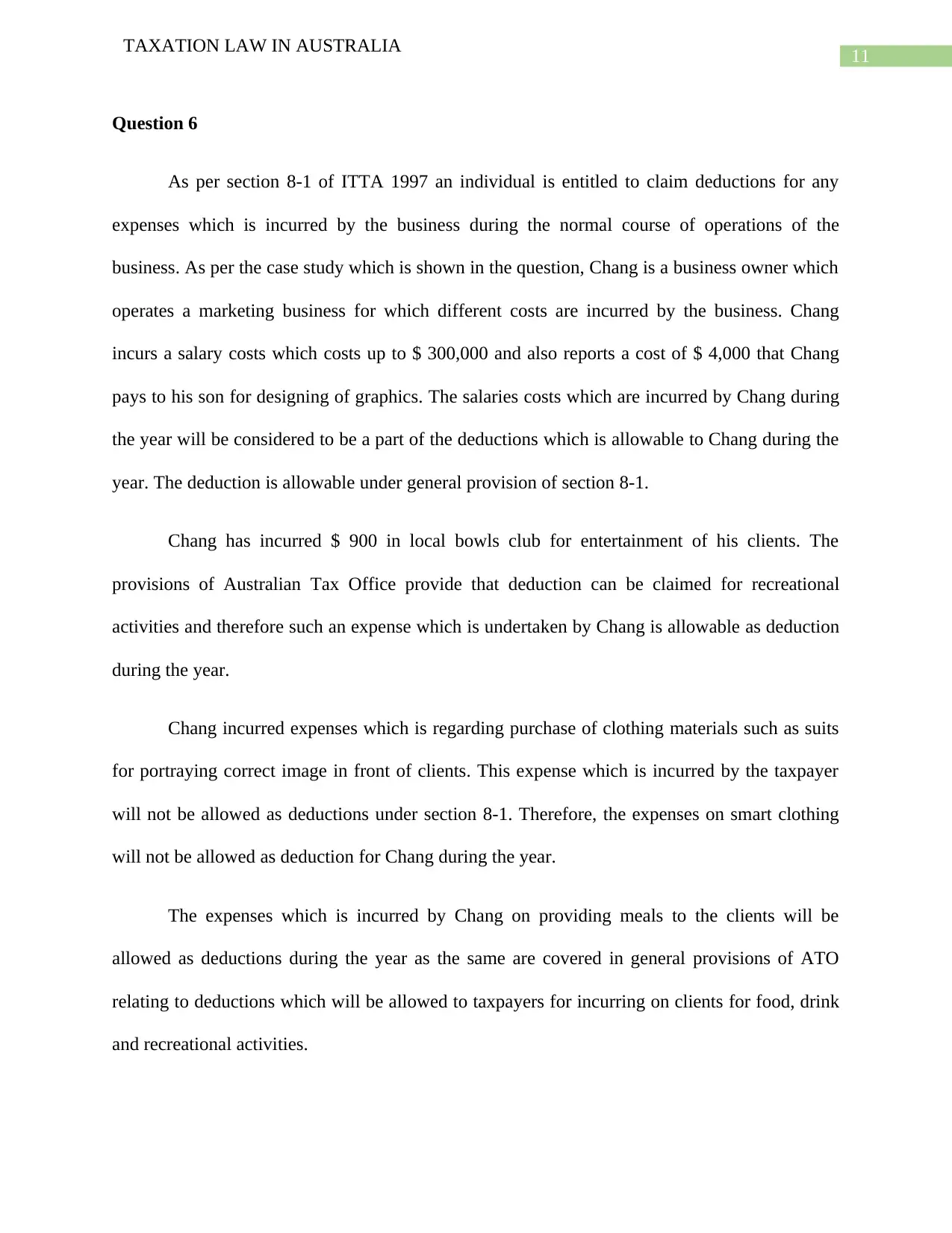
11
TAXATION LAW IN AUSTRALIA
Question 6
As per section 8-1 of ITTA 1997 an individual is entitled to claim deductions for any
expenses which is incurred by the business during the normal course of operations of the
business. As per the case study which is shown in the question, Chang is a business owner which
operates a marketing business for which different costs are incurred by the business. Chang
incurs a salary costs which costs up to $ 300,000 and also reports a cost of $ 4,000 that Chang
pays to his son for designing of graphics. The salaries costs which are incurred by Chang during
the year will be considered to be a part of the deductions which is allowable to Chang during the
year. The deduction is allowable under general provision of section 8-1.
Chang has incurred $ 900 in local bowls club for entertainment of his clients. The
provisions of Australian Tax Office provide that deduction can be claimed for recreational
activities and therefore such an expense which is undertaken by Chang is allowable as deduction
during the year.
Chang incurred expenses which is regarding purchase of clothing materials such as suits
for portraying correct image in front of clients. This expense which is incurred by the taxpayer
will not be allowed as deductions under section 8-1. Therefore, the expenses on smart clothing
will not be allowed as deduction for Chang during the year.
The expenses which is incurred by Chang on providing meals to the clients will be
allowed as deductions during the year as the same are covered in general provisions of ATO
relating to deductions which will be allowed to taxpayers for incurring on clients for food, drink
and recreational activities.
TAXATION LAW IN AUSTRALIA
Question 6
As per section 8-1 of ITTA 1997 an individual is entitled to claim deductions for any
expenses which is incurred by the business during the normal course of operations of the
business. As per the case study which is shown in the question, Chang is a business owner which
operates a marketing business for which different costs are incurred by the business. Chang
incurs a salary costs which costs up to $ 300,000 and also reports a cost of $ 4,000 that Chang
pays to his son for designing of graphics. The salaries costs which are incurred by Chang during
the year will be considered to be a part of the deductions which is allowable to Chang during the
year. The deduction is allowable under general provision of section 8-1.
Chang has incurred $ 900 in local bowls club for entertainment of his clients. The
provisions of Australian Tax Office provide that deduction can be claimed for recreational
activities and therefore such an expense which is undertaken by Chang is allowable as deduction
during the year.
Chang incurred expenses which is regarding purchase of clothing materials such as suits
for portraying correct image in front of clients. This expense which is incurred by the taxpayer
will not be allowed as deductions under section 8-1. Therefore, the expenses on smart clothing
will not be allowed as deduction for Chang during the year.
The expenses which is incurred by Chang on providing meals to the clients will be
allowed as deductions during the year as the same are covered in general provisions of ATO
relating to deductions which will be allowed to taxpayers for incurring on clients for food, drink
and recreational activities.
⊘ This is a preview!⊘
Do you want full access?
Subscribe today to unlock all pages.

Trusted by 1+ million students worldwide
1 out of 15
Related Documents
Your All-in-One AI-Powered Toolkit for Academic Success.
+13062052269
info@desklib.com
Available 24*7 on WhatsApp / Email
![[object Object]](/_next/static/media/star-bottom.7253800d.svg)
Unlock your academic potential
Copyright © 2020–2025 A2Z Services. All Rights Reserved. Developed and managed by ZUCOL.

